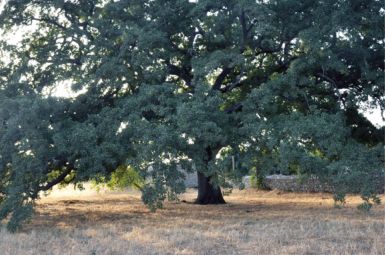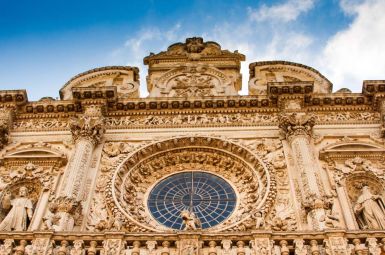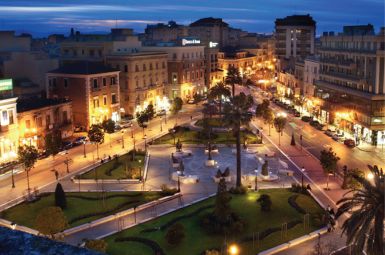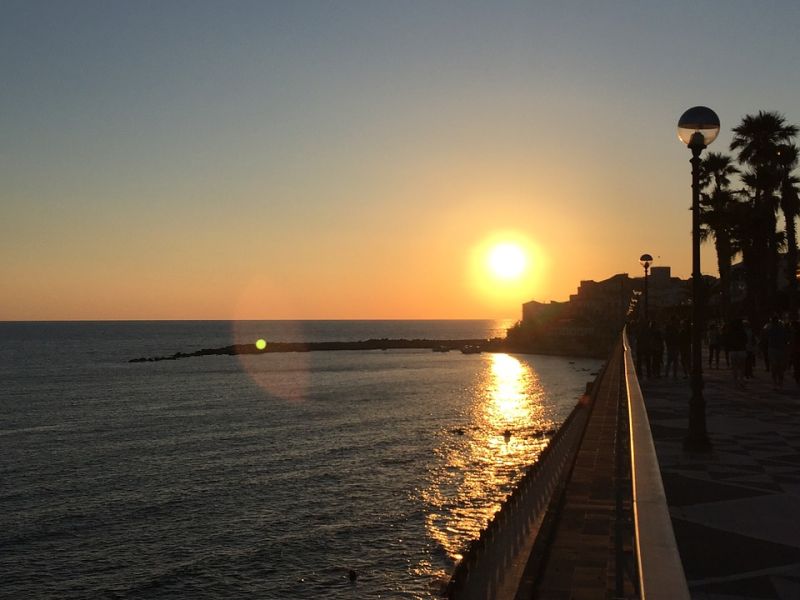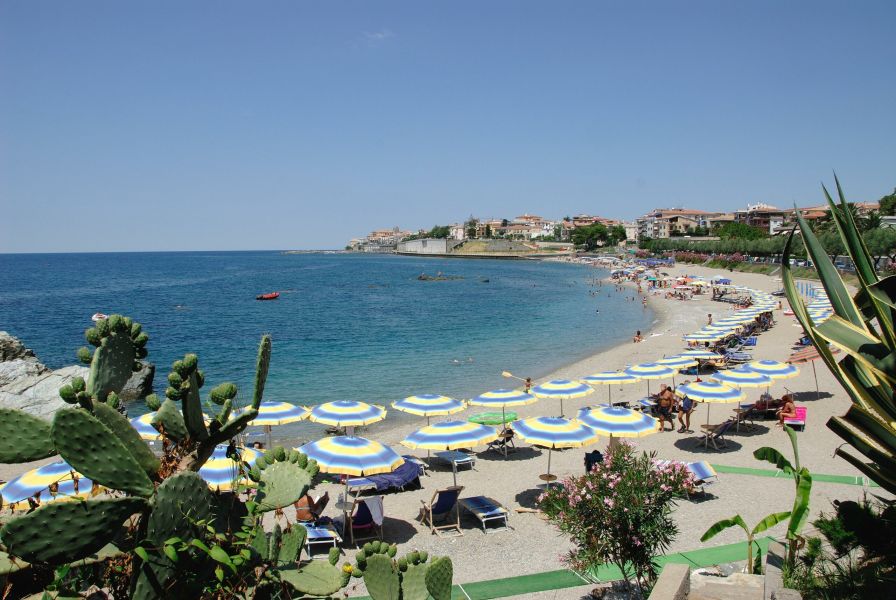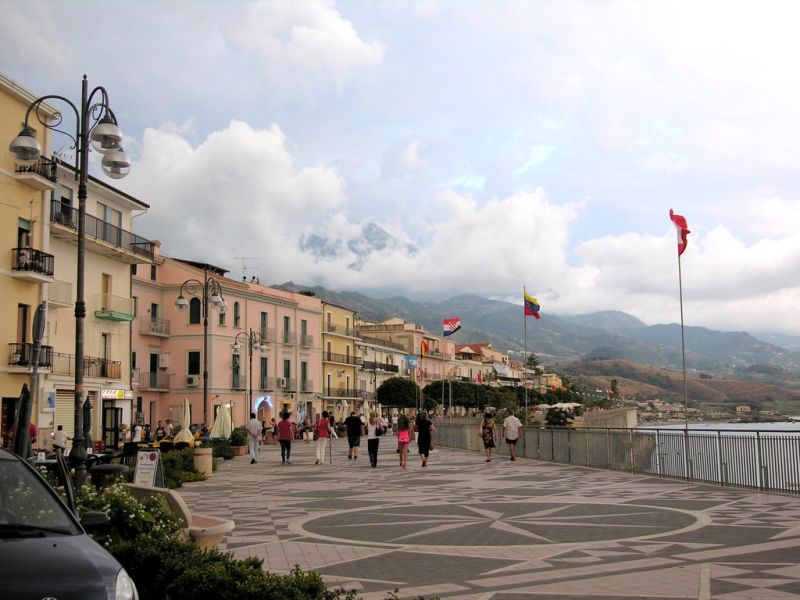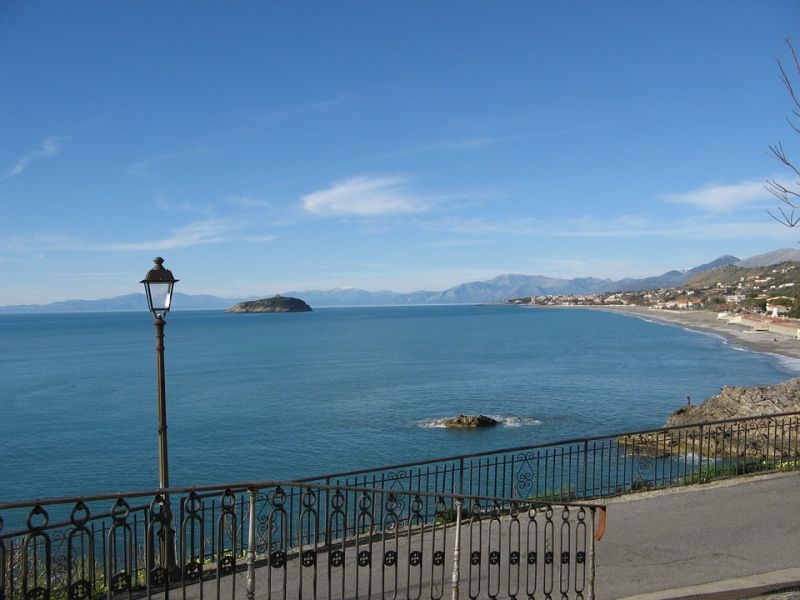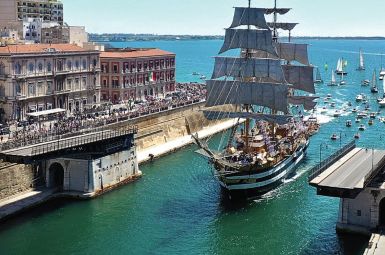
Il Borgo di Diamante
Diamante: Il Ciliegio sul Mare e la Capitale del Peperoncino
L’Essenza della Calabria Tirrenica: Arte Murale, Tradizione Marinara e Sapore Piccante.
Affacciata sul suggestivo tratto della Riviera dei Cedri in Calabria, Diamante non è solo un borgo marinaro, ma una tela a cielo aperto che pulsa di colore, arte popolare e una spiccata identità gastronomica. Il suo nome evoca la luminosità e la bellezza, ma la sua anima è legata indissolubilmente al fuoco del peperoncino.
L’Arte sui Muri: Il Borgo Dipinto
Il tratto più distintivo e affascinante di Diamante è l’incredibile galleria d’arte a cielo aperto che anima il suo centro storico.
-
I Murales: A partire dagli anni ’80, artisti di fama nazionale e internazionale hanno trasformato i muri delle case del borgo in oltre 200 murales che raccontano la storia, le leggende, il folklore e la vita quotidiana della Calabria. Passeggiare per i vicoli stretti e tortuosi (carruggi) di Diamante significa compiere un viaggio visivo unico, dove l’architettura si fonde con la pittura.
-
La “Testa del Turco”: I vicoli del centro storico conservano l’antica struttura a difesa delle incursioni saracene, creando un dedalo che sfocia a sorpresa sul mare.
Il Dominio del Peperoncino
Diamante si è guadagnata il titolo di “Capitale del Peperoncino” grazie a un legame profondo e festoso con questo ingrediente che è un simbolo della cucina calabrese.
-
L’Accademia e il Festival: Ogni anno, la città ospita il celebre Festival del Peperoncino, un evento internazionale organizzato dall’Accademia Italiana del Peperoncino. La manifestazione celebra il “Diavolillo” con degustazioni, spettacoli, dibattiti e, naturalmente, gare piccanti, attirando migliaia di appassionati da tutto il mondo.
L’Isola di Cirella e la Riviera dei Cedri
Di fronte al litorale di Diamante si staglia l’incantevole e disabitata Isola di Cirella, un faraglione di roccia calcarea che arricchisce il panorama. Le sue acque cristalline sono perfette per le immersioni.
Diamante è, in definitiva, una meta che unisce il fascino visivo dell’arte urbana con la ricchezza del mare e l’esplosione dei sapori piccanti, incarnando la vivace e accogliente ospitalità della Calabria tirrenica.
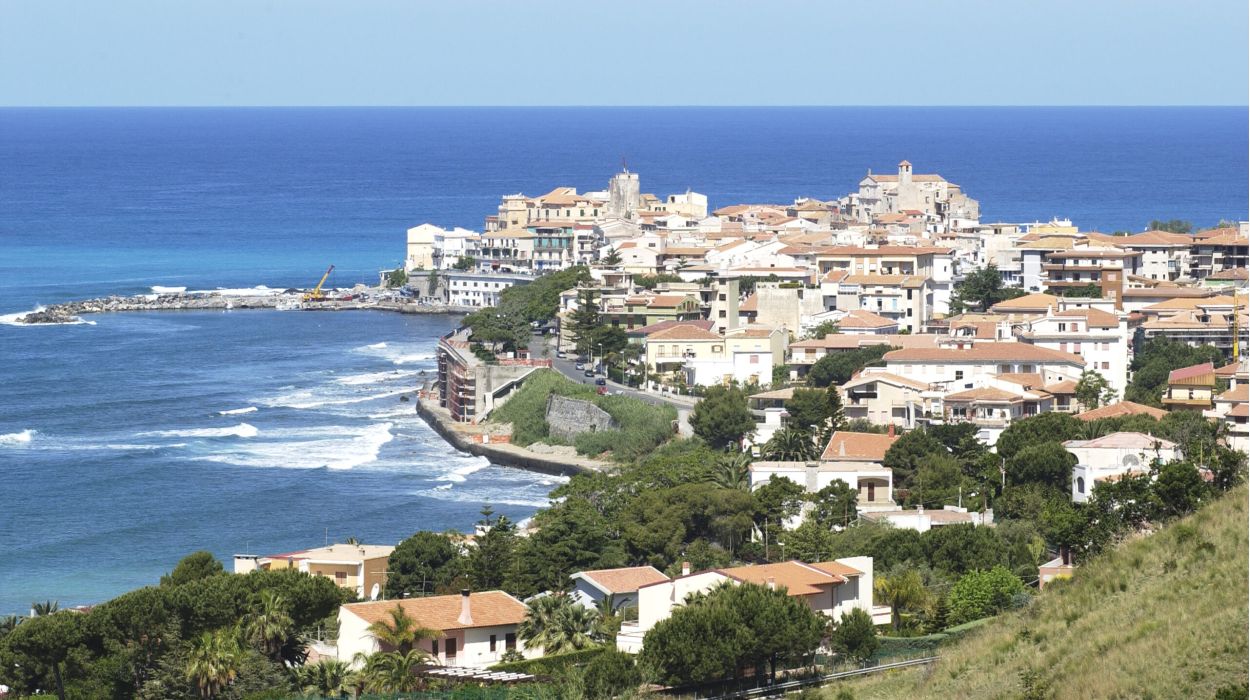
Il Borgo d’Italia
tutto da scoprire ed esplorare
Monumenti
Diamante: Il Patrimonio Visivo tra Arte Urbana e Fortificazioni Tirreniche
Oltre la Tela: I Monumenti che Fanno di Diamante una Gallerie d’Arte a Cielo Aperto.
Diamante, gemma della Riviera dei Cedri in Calabria, possiede un patrimonio monumentale che si distingue per la sua natura duplice: da un lato, le tradizionali architetture storiche e difensive; dall’altro, un monumento diffuso e vibrante costituito dalla sua ineguagliabile arte urbana. I monumenti di Diamante non sono solo quelli di pietra, ma quelli dipinti sui suoi muri.
1. I Murales: Il Monumento Diffuso e Collettivo
Il vero e inimitabile monumento di Diamante è il suo centro storico interamente affrescato.
-
La Tela della Città: A partire dal 1981, sotto l’iniziativa del pittore Nani Razetti, oltre 200 murales sono stati realizzati da artisti provenienti da tutto il mondo. Questa straordinaria galleria all’aperto trasforma i vicoli stretti (carruggi) in un percorso museale dinamico e vivente.
-
Narrazione in Colore: I murales non sono semplici decorazioni, ma vere e proprie narrazioni monumentali che raccontano la storia del borgo, le leggende marinare, le tradizioni popolari, il folklore calabrese e la vita dei pescatori, offrendo una testimonianza unica dell’identità culturale della regione.
2. Le Fortificazioni Marittime: Il Baluardo Storico
Il borgo, sorto come avamposto contro le incursioni saracene, conserva i segni di questa funzione difensiva:
-
I Ruderi del Castello: Sebbene non sia rimasto un castello integro, i resti delle antiche mura difensive e delle torri di avvistamento che un tempo proteggevano il centro abitato sono ancora visibili, specialmente nella parte alta del paese, testimoniando la sua resilienza storica.
3. La Chiesa di San Biagio: Il Cuore Spirituale
Il punto focale della vita religiosa e civica del borgo è la Chiesa di San Biagio Vescovo e Martire, patrono della città.
-
Architettura e Fede: Posta nel nucleo storico, la chiesa, sebbene abbia subito diverse modifiche nel tempo, si presenta con un’austera facciata che contrasta con l’esplosione cromatica dei vicoli circostanti. Custodisce opere sacre e arredi che raccontano la profonda fede marinara della comunità.
4. L’Isola di Cirella e la Torre di Avvistamento
Elemento monumentale del paesaggio, sebbene non direttamente in città, l’Isola di Cirella e le sue strutture associate sono inscindibili dall’identità di Diamante.
-
L’Antico Avamposto: Sull’isola e sulla costa circostante si ergono i resti di antiche torri di avvistamento del XVI e XVII secolo, costruite per difendere la costa dalle scorrerie dei pirati turchi. Queste rovine, tra cui la torre sulla sommità dell’isolotto di Cirella, sono suggestive sentinelle che dominano il Tirreno.
A Diamante, l’architettura storica e la street art si fondono, offrendo un’esperienza monumentale che è al tempo stesso un viaggio nel passato fortificato e un’immersione nell’espressione artistica contemporanea.
Curiosità
Diamante: Le Storie Piccanti e i Segreti del Borgo Pitturato
Curiosità in Technicolor: Dove l’Arte, il Diavolillo e la Storia si Incontrano sul Tirreno.
Diamante è una città di contrasti vivaci e storie inaspettate, un luogo dove l’orgoglio marinaro e l’esuberanza calabrese si esprimono attraverso il colore e il sapore. Al di là delle sue spiagge, il borgo cela aneddoti e peculiarità che lo rendono una meta unica sulla Riviera dei Cedri.
1. La Nascita della “Galleria a Cielo Aperto”
La curiosità più nota di Diamante è l’origine dei suoi celebri Murales, un progetto che ha trasformato il borgo in un monumento d’arte contemporanea diffusa.
-
L’Idea del Sogno: L’iniziativa prese vita nel 1981, grazie all’intuizione del pittore locale Nani Razetti e con il sostegno dell’allora Sindaco. L’obiettivo era riqualificare il centro storico e contrastare lo spopolamento, invitando artisti italiani e stranieri a dipingere sui muri fatiscenti delle case.
-
Un Esperimento Riuscito: L’esperimento coinvolse oltre 80 artisti che, in una sola settimana, realizzarono i primi 55 murales. Oggi sono più di 200, e la città ha creato un vero e proprio “Parco d’Arte”, unico per la sua densità e la sua integrazione con la vita quotidiana.
2. Il “Diavolillo”: Il Piatto Forte della Città
Diamante non è solo la capitale del peperoncino per modo di dire, ma lo è per statuto e passione, celebrando una cultura gastronomica che risale a secoli fa.
-
L’Accademia che Diede un Nome: La città è la sede dell’Accademia Italiana del Peperoncino, fondata nel 1994, che ha il merito di aver innalzato il Capsicum da semplice ingrediente a vera e propria icona culturale.
-
La Scusa per la Festa: Il celebre Festival del Peperoncino nasce come celebrazione di questo legame, ma ha una valenza che va oltre la gastronomia: è un evento che attira personalità e studiosi da tutto il mondo per dibattiti, spettacoli e, naturalmente, il rito delle degustazioni piccanti. Il peperoncino è così radicato che è un elemento imprescindibile di ogni specialità locale.
3. I Segreti della “Testa del Turco”
Il centro storico di Diamante, con i suoi vicoli stretti, ripidi e a volte bui, è un retaggio delle necessità difensive marittime.
-
Architettura Anti-Invasione: La struttura a labirinto dei carruggi era funzionale a difendersi dalle incursioni saracene (o turche) che flagellavano il Tirreno. Questi vicoli non solo rallentavano l’avanzata degli invasori, ma erano studiati per intrappolarli e confonderli.
-
La Statua Portafortuna: Una curiosità che lega la città a questa storia è la presenza di statue o raffigurazioni della “Testa del Turco” (un uomo barbuto con turbante), usate non solo come monito ma anche, secondo il folklore locale, come amuleto portafortuna contro il “malocchio” e il pericolo.
4. L’Isola di Cirella: La Cattedrale Sommersa
Di fronte a Diamante si staglia l’Isola di Cirella, un elemento paesaggistico che nasconde misteri sottomarini.
-
Le Navi Affondate: Oltre alle rovine della torre di avvistamento sull’isola stessa, le acque che circondano l’isolotto sono un paradiso per gli appassionati di immersioni. Qui si trovano diversi relitti navali, risalenti a epoche diverse, che fanno del fondale marino una vera e propria “cattedrale sommersa”, ricca di storia e vita marina.
Diamante è un borgo che sorprende per la sua capacità di celebrare la propria storia, anche quella più drammatica, trasformandola in un’espressione artistica dirompente.
Personaggi
L’Orgoglio di Diamante: I Figli della Riviera tra Arte, Fede e Sapori
Radici Piccanti: Le Personalità Nativi che Hanno Onorato il Borgo Calabrese
Diamante, pur essendo un piccolo e vivace centro della costa tirrenica, ha dato i nativi a figure che hanno contribuito ad arricchire la cultura e l’identità non solo locale, ma dell’intera regione calabrese. La sua storia, strettamente legata al mare e alla fede, si riflette nelle personalità che l’hanno resa celebre.
1. Il Padre Fondatore dell’Arte: Nani Razetti
Sebbene non sia nato direttamente a Diamante, la figura che ha plasmato l’identità moderna e artistica del borgo è così strettamente legata alla città da esserne considerato il vero ispiratore e figlio adottivo: Nani Razetti (1918 – 1999).
-
Il Visionario dei Murales: Razetti fu l’artista e l’intellettuale che ideò e promosse il progetto dei murales nel 1981, trasformando Diamante nel “Borgo Dipinto” che conosciamo oggi. Il suo impatto sul borgo fu monumentale, creando una galleria a cielo aperto che ha fatto scuola in Italia e nel mondo, garantendo a Diamante fama internazionale e nuova vita.
2. Le Figure della Fede: Il Patrono Nascosto
L’identità religiosa di Diamante è storicamente legata a una figura di profonda devozione:
-
San Biagio Vescovo e Martire: Sebbene non sia un nativo di Diamante, la profonda devozione al patrono, San Biagio, ha plasmato l’identità civica e religiosa per secoli. Le celebrazioni in suo onore e la sua chiesa (Chiesa di San Biagio) sono un pilastro della vita comunitaria, riflettendo la fede tenace dei marinai locali.
3. I Custodi del Sapore: I Contributori Gastronomici
Una menzione d’onore spetta a tutti quei maestri artigiani e cuochi nativi che, pur non essendo noti al grande pubblico, hanno conservato e tramandato l’arte della preparazione del peperoncino e dei prodotti tipici locali.
-
L’Eredità del “Diavolillo”: Sono i nativi di Diamante che hanno mantenuto viva la coltivazione del “Diavolillo”, l’essiccazione delle sartizzu (salsicce) e l’arte di trasformare i sapori piccanti in tradizione. La loro tenacia ha permesso la nascita dell’Accademia Italiana del Peperoncino e del Festival, eventi che hanno posto Diamante sulla mappa internazionale del gusto.
Il vero monumento umano di Diamante è l’insieme della sua comunità artistica e popolare, la cui energia e il cui talento hanno saputo dare colore e sapore a una storia millenaria.
Ricette Tipiche
Diamante in Tavola: L’Esplosione di Sapori Tra Mare e Peperoncino
Gusto Calabrese Senza Filtri: Le Ricette che Hanno Reso Celebre la Capitale del Piccante.
La cucina di Diamante è un riflesso fedele della sua identità: vibrante, schietta e inseparabile dall’aroma intenso del mare e dal fuoco sacro del “Diavolillo” (il peperoncino calabrese). Le ricette tipiche sono un inno alla semplicità dei prodotti locali, capaci di trasformare ingredienti poveri in vere e proprie esperienze culinarie.
1. Il Piatto Iconico: La Frittata di Rosamarina (o Sardella)
Questo è il piatto che più di ogni altro celebra il legame tra Diamante, il mare e il peperoncino, incarnando la vera essenza della cucina marinara calabrese.
-
L’Oro del Mare: La Rosamarina (o sardella) è il nome dato al novellame di pesce azzurro (neonata di sarde o acciughe) pescato in primavera.
-
La Preparazione Piccante: Le neonatine vengono sapientemente mescolate con un impasto a base di peperoncino in polvere (che conferisce il tipico colore rosso fuoco), aglio e finocchietto selvatico, e poi fritte. Il risultato è una frittata croccante all’esterno e morbidissima all’interno, dall’inconfondibile sapore salmastro e ardente. È un piatto che si degusta tradizionalmente accompagnato da pane fresco e un bicchiere di vino bianco ghiacciato.
2. Il Conforto Contadino: I Lagane e Ceci Piccanti
Sebbene Diamante sia una città di mare, la sua tradizione include ricette robuste provenienti dall’entroterra, basate sui legumi e sulla pasta povera.
-
La Pasta Povera: Le Lagane sono una pasta lunga e larga, realizzata con sola farina di grano duro e acqua (senza uova), un formato antichissimo che conferisce al piatto una consistenza rustica e tenace.
-
Il Condimento Rustico: Vengono condite con un sugo denso a base di ceci (spesso dell’entroterra dell’Alto Tirreno cosentino) rosolati con abbondante aglio, olio extravergine d’oliva e, immancabilmente, un tocco generoso di peperoncino rosso fresco o secco. Un piatto unico, energico e avvolgente.
3. La Dolcezza di Mezzogiorno: Il Bocconotto Calabrese
Nella pasticceria, la tradizione di Diamante si addolcisce, pur mantenendo un legame con le materie prime locali e le contaminazioni storiche.
-
Il Piccolo Morso: Il Bocconotto (o buccunotto), diffuso in tutta la regione, è un dolce a forma di cestino fatto di pasta frolla, cotto al forno e tradizionalmente ripieno di marmellata di agrumi (spesso cedro, che è l’eccellenza della vicina Riviera) e ricoperto da una spolverata di zucchero a velo. È il dolce tipico da offrire agli ospiti e da gustare durante le festività.
4. Il Tesoro della Costa: Il Pesce Spada
La ricchezza del mare di Diamante offre pescati pregiati, tra cui il Pesce Spada, preparato in modi che ne esaltano la carne delicata.
-
Il Pesce Spada a Ghiotta: Una delle preparazioni locali più diffuse vede il Pesce Spada cucinato “alla Ghiotta”, ovvero in un sugo saporito a base di pomodorini freschi, olive nere, capperi, origano e, ovviamente, una punta di peperoncino, creando un equilibrio perfetto tra mare, terra e piccantezza.
La cucina di Diamante è un’esplosione di sapori autentici che cattura l’essenza della Calabria: calda, generosa e indimenticabilmente piccante.
